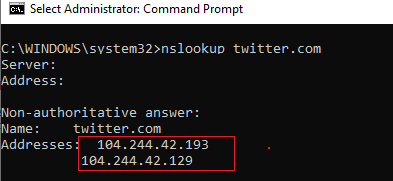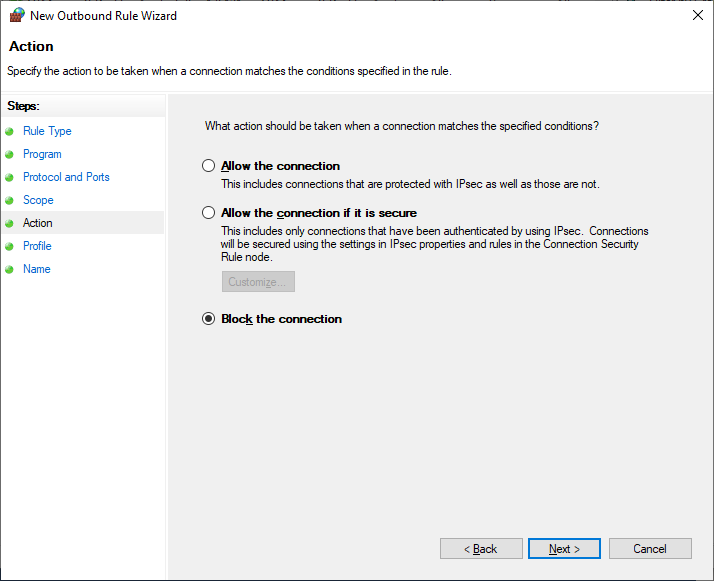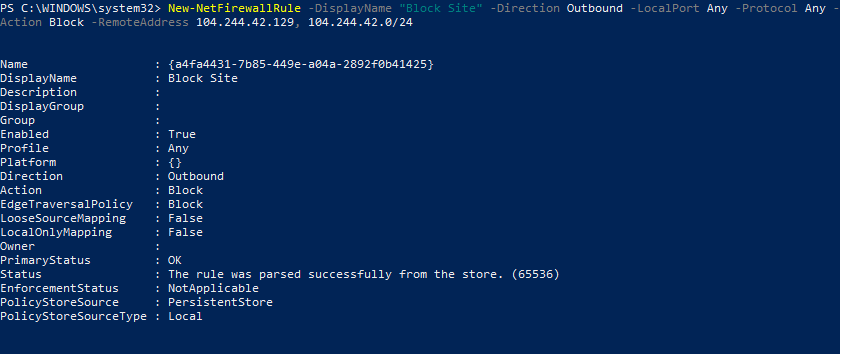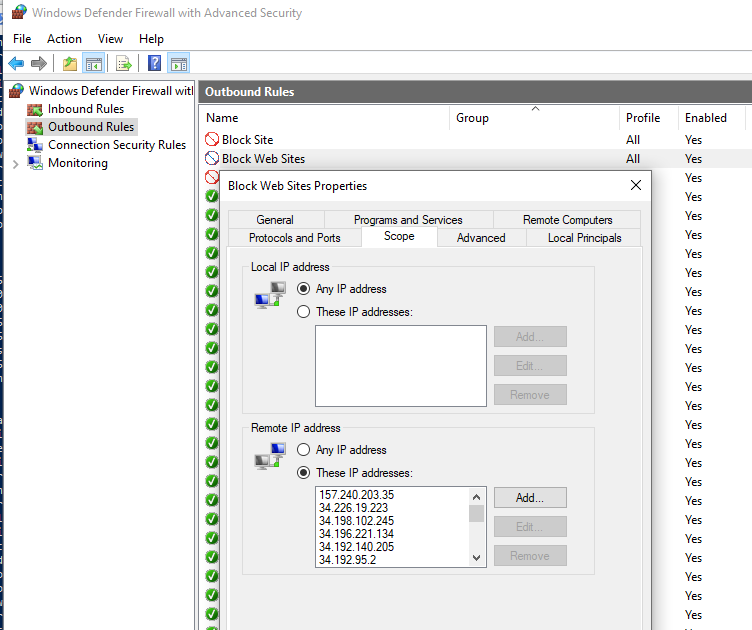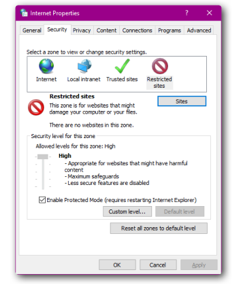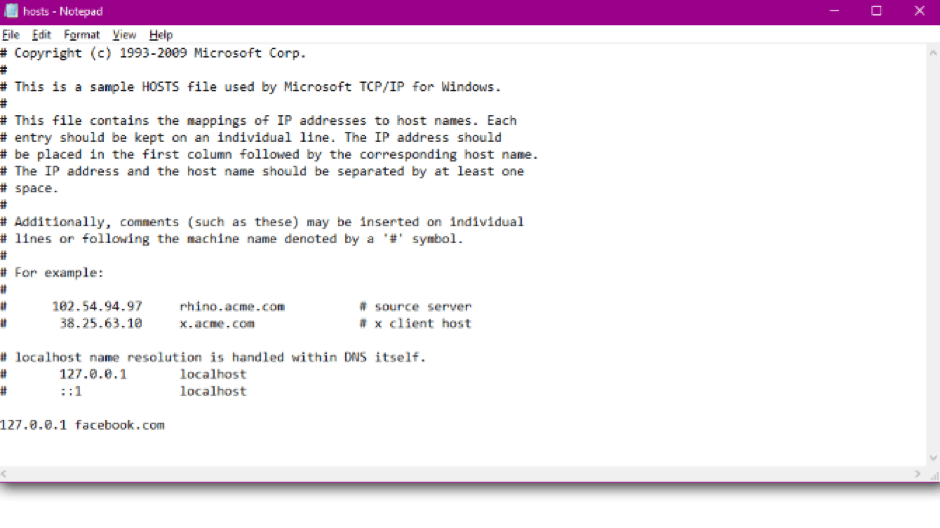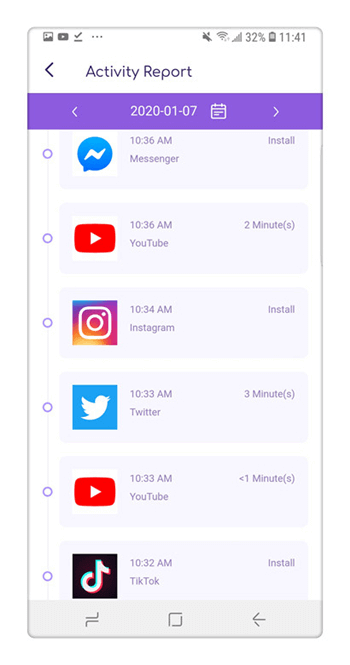- How to Block a Domain or Website on Windows Defender Firewall with PowerShell?
- Blocking Websites Using the Hosts File in Windows
- Block Websites Using DNS Filtering
- How to Block Website IP Address in Windows Defender Firewall?
- Using PowerShell to Create Firewall Rule to Block Website by Domain Name or IP Address
- Related Reading
- How to Run Windows File Explorer Elevated (as.
- Using Malicious Software Removal Tool (MRT.exe) on Windows
- How to Clean Up Large System Volume Information.
- Read and Write Data to Excel File with.
- How to Disable NetBIOS and LLMNR Protocols in.
- 2 comments
- How To Block Websites On Windows 7?
- ALL TOPICS
- How to block a site on Windows 7
- FamiSafe Website Filter — how to block websites on phones?
How to Block a Domain or Website on Windows Defender Firewall with PowerShell?
Let’s consider some ways to block access to the specific websites, domain names, URLs or IP addresses in Windows without using third-party tools. In our case, we will try to block certain websites using the built-in Windows 10 tools and PowerShell automation features.
Blocking Websites Using the Hosts File in Windows
The most popular method to block a specific website on Windows is to edit the hosts file. Usually it is located in %windir%\system32\drivers\etc\ directory. Please note that hosts file does not have an extension.
The hosts file is used to manually assign mappings between IP addresses and DNS names. When resolving names, the hosts has higher priority than DNS servers specified in the network connection settings.
To block a specific website (for example, facebook.com), open the hosts file (with the administrator privileges) and add the strings like these to it:
Save the file and restart your computer (or clear the DNS cache using the command: ipconfig /flushdns ).
After that, when trying to open the facebook.com in any browser you will see the message “Page not found” / “Page not available”.
You can add new lines containing website URLs to your hosts file using such a .bat file:
@echo off
set hostspath=%windir%\System32\drivers\etc\hosts
echo 127.0.0.1 www.facebook.com >> %hostspath%
echo 127.0.0.1 facebook.com >> %hostspath%
exit
Or you can use the following PowerShell functions to automatically block specific websites in your hosts file.
Function BlockSiteHosts ( [Parameter(Mandatory=$true)]$Url) <
$hosts = ‘C:\Windows\System32\drivers\etc\hosts’
$is_blocked = Get-Content -Path $hosts |
Select-String -Pattern ([regex]::Escape($Url))
If(-not $is_blocked) <
$hoststr=»127.0.0.1 ” + $Url
Add-Content -Path $hosts -Value $hoststr
>
>
Function UnBlockSiteHosts ( [Parameter(Mandatory=$true)]$Url) <
$hosts = ‘C:\Windows\System32\drivers\etc\hosts’
$is_blocked = Get-Content -Path $hosts |
Select-String -Pattern ([regex]::Escape($Url))
If($is_blocked) <
$newhosts = Get-Content -Path $hosts |
Where-Object <
$_ -notmatch ([regex]::Escape($Url))
>
Set-Content -Path $hosts -Value $newhosts
>
>
To add a website to the list of blocked URLs, just execute the command:
To unblock the website, run:
Block Websites Using DNS Filtering
If your clients use the same DNS server, in the same way you can block certain websites by creating a DNS entry in that DNS and specify something like 127.0.0.1 in it. By the way, most commercial DNS content filters (OpenDNS, SafeDNS, Cisco Umbrella, etc.) use the same principle.
How to Block Website IP Address in Windows Defender Firewall?
Also, you can block some websites using the built-in Windows Defender Firewall. The main disadvantage of this method is that you won’t be able to use the name of a domain or a website URL in the blocking rule. Windows Defender Firewall allows you to specify only an IP address or a subnet as a source/destination.
First of all, you have to get the IP address of the website you want to block. It is easier to do it using the nslookup command:
As you can see, the command has returned several IP addresses assigned to the website. You have to block all of them.
Run the Windows Defender Firewall management snap-in (Control Panel\All Control Panel Items\Windows Defender Firewall\Advanced Settings or by running firewall.cpl).
In the Outbound Rules section, create a new rule with the following settings:
- Rule Type: Custom
- Program: All programs
- Protocol Type: Any
- Scope: In the “Which remote IP addresses does this rule apply to?” section select “These IP addresses” -> Add. In the next window, enter the IP addresses, subnets or a range of IP addresses you want to block.
Click OK -> Next -> Action -> Block the connection.
Leave all options as they are in the window with Firewall profiles the rule is applied to. Then specify the rule name and save it.
After that Windows Defender Firewall will block all outgoing connections to the specified website’s IP addresses. The following message will appear in your browser when trying to connect to the blocked site:
In your AD domain you can deploy a Windows Firewall policy to block access to a website on user computers using GPO. However, it is not rational. It is better to filter websites on your Internet access router (gateway).
Using PowerShell to Create Firewall Rule to Block Website by Domain Name or IP Address
You can also create a Firewall rule that blocks the connection to the website using PowerShell:
New-NetFirewallRule -DisplayName «Block Site» -Direction Outbound –LocalPort Any -Protocol Any -Action Block -RemoteAddress 104.244.42.129, 104.244.42.0/24
The string “The rule was parsed successfully from the store” means that the new Firewall rule has been successfully applied. You can find it in the graphical interface of your Windows Defender Firewall.
In order not to resolve the website names into IP addresses manually, you can use the Resolve-DnsName PowerShell cmdlet to get the website IP addresses:
Resolve-DnsName «twitter.com»| Select-Object -ExpandProperty IPAddress
Thus, you can convert the name of the website into its IP addresses and add a block rule to the firewall settings:
$IPAddress = Resolve-DnsName «twitter.com»| Select-Object -ExpandProperty IPAddress
New-NetFirewallRule -DisplayName «Block Site» -Direction Outbound –LocalPort Any -Protocol Any -Action Block -RemoteAddress $IPAddress
So you can now add a blocking rule to your Windows Firewall for multiple websites at once:
$SitesToBlock = «facebook.com»,»instagram.com»,»youtube.com»
$IPAddress = $SitesToBlock | Resolve-DnsName -NoHostsFile | Select-Object -ExpandProperty IPAddress
New-NetFirewallRule -DisplayName «Block Web Sites» -Direction Outbound –LocalPort Any -Protocol Any -Action Block -RemoteAddress $IPAddress
I have added the –NoHostsFile parameter to the Resolve-DnsName cmdlet in order not to use the hosts file for resolving.
Let’s make sure that a block outbound rule has appeared in the Windows Firewall console.
This article is mostly a brain training exercise. In a corporate network, you must use website filtering on your Internet access gateway, router or a proxy server. The host-level blocking is not very effective.
Extend Volume Blocked by a Recovery Partition on Windows 10
Hyper-V Boot Error: The Image’s Hash and Certificate Are not Allowed
Related Reading
How to Run Windows File Explorer Elevated (as.
Using Malicious Software Removal Tool (MRT.exe) on Windows
How to Clean Up Large System Volume Information.
Read and Write Data to Excel File with.
How to Disable NetBIOS and LLMNR Protocols in.
2 comments
1. Resolving an URL to an IP and then blocking that IP is hardly a guarantee of prevention. In some cases, there are many IPs that lead to URL, in some cases an IP leads to many URLs which may be ones you need or want to get access to. You should mention this aspect when you talk about that aspect of things.
2. I just ran into the oddest scenario which has me now pointing undesirable URLs to an IP address in my local net that my DHCP server will never assign (nor will I) vs. the loopback interface (127.0.0.1). Why?
Well, I found with some of the google stuff I was trying to block and routed to 127.0.0.1, when I did a netstat -s or netstat -a -n -o, I observed that there were a bunch of connections targeted at the name the google software was looking for that had *CONNECTED* to something on 127.0.0.1 (both the local and foreign addresses were on the loopback interface). I bet there are apps that you want to block that act both as client and server so looping back forms a connection back to your own machine. While this does keep those attempts back within your machine, it still seems undesirable.
My solution here was to identify a network address locally that DNE and never will (outside my DHCP allocation pool, will not be statically created by me – which also implies that I have entire control over the network which I do) and then use the hosts file to send these requests to a dead end. Is that better than having them loopback, never hit the network, and connect to something locally? I really don’t know. I am hoping with the address translation from an URL to a host in the hosts file (to a dead address on the network) and then using Windows Defender to block outgoing requests for that dead IP, that combination will result in the firewall just quietly eating the outside connect requests so a) there will be no connections back to my machine in loopback and b) there will be no extra connection requests firing into the local network (because Defender blocked them).
Just some extra strategies for the thought experiment. I do appreciate the article for the knowledge you have conveyed – thank you.
One further point: If you don’t control the network, there are still ‘reserved’ internet address ranges that for the most part are not supposed to be used in normal networks. It is possible for you to use one of those ranges to send the requests to (as it isn’t likely to catch a host on your network) and then kill that address with IP based blocking in Defender Firewall.
Note, do not use the Link Address range (which is used for when a DHCP server is not available and DHCP clients are trying to assign themselves (no central direction) an IP address that does not conflict with another using trial-error-retry with new address approach). Leave that address band alone, but there are still other reserved address ranges you could use. I’d still put a Firewall block on outgoing traffic to those just to not put things onto your local net and make your router/switch/access point/etc have to make a decision about what to do with that traffic (why waste the devices time?). Block it locally as an outgoing address on your box.
In MOST cases, this approach should not impede any local software.
One somewhat useful (depends on how machines on your network setup ping handling) way to test a reserved address on your local net would be to ping it from the command line. That would tell you if it was occupied if you got a ping response. (Does not tell you nothing might be there if you do not – machine could be off temporarily or be set not to return ICMP echoes when pinged). But if you do get a response on a reserved internet address, try another. There are 3 or 4 ranges with a lot of addresses in them in the list of reserved addresses.
(PS I’m talking IPv4 here – haven’t looked into any reserved address ranges in IP V6)
How To Block Websites On Windows 7?
Block Websites & Internet Filter
ALL TOPICS
Thomas Jones
Jan 07, 2021 Filed to: Internet Filter Proven solutions
The Internet is a virtual world of information. It has so many things to offer that sometimes we get carried away without using our senses. Uncountable websites provide legal and illegal information that is not easy to identify. The possibilities of the Internet are infinite, but we must know which information is useful for us. The undesirable contents can be easily avoided by knowing how to block websites on computers. This article will guide you on how to block websites on Windows 7.
How to block a site on Windows 7
There are a lot of reasons behind blocking websites.
- For parents that wish to provide a safe and clean online environment for their young kids, it is necessary to block websites that contain information like pornography, gambling, drug on their computers.
- Illegal contents and viruses are prevailing through a certain website. Some websites can spread malware or steal personal information simply by clicking on them.
- For employers, if their employees can go online without any restrictions, they may spend too much time browsing meaningless websites or communicating with their friends on social media platforms. Thus for industrial and official zones, websites are restricted to buck up the employee’s working potentiality and avoid wastage of time.
Here are three easy methods on how to block websites on Windows 7;
#1 Add to restricted sites on Chrome
Adding restricted sites on Chrome are one of the easiest methods to block websites on your Windows PC. Irrespective of what versions of Windows you use, if you are using Chrome, you may follow the below simple steps;
- Click on Google Chrome settings. Scroll to the advanced settings
- Under the system tab, click on open proxy settings
- Click on the Security Tab and select the Restricted Sites.
- Click on sites that you want to restrict.
- In the dialog box, you can enter the URLs of the sites that you want to restrict. Click on the Add button.
The downside of these settings is that it is not password-protected, and anyone can change the settings.
#2 Block websites by editing Windows Host
Blocking the websites by the Windows host method is one of the most popular ways to block websites. You can edit the Windows host file to block the websites for the Chrome browser. Here is how to block websites on Windows 7;
- Click on the Start Menu
- Type in the search box C:\Windows\system32\drivers\etc
- Right-click on the Host and open it on the Notepad
- You need to type the following at the bottom of the document -127.0.0.1, along with a space followed by the URL of the websites that you want to block.
- For example, if you want to block Twitter, you have to type 127.0.0.1 Twitter.com. you cannot use HTTP or www with the URL that you have entered.
- There is no limit to the number of URLs you want to block.
- Make sure that the URLs are entered in separate lines, and you save the document before closing them.
- Restart your computer and search for the blocked site. You will notice that they won’t open anymore.
#3 Block a Site on mainstream browsers — Using Parental Control Software
Parental control software is among the most secure way to block the websites on your windows and simultaneously keep an eye on your children. There is various software that you can download from the Google app or App Store. They are easy to use and highly customizable, as well.
FamiSafe parental control software is compatible with both PC and mobile. However, if you are looking for an app for a wide range of protection, you can not miss FamiSafe.
- Track daily screen time and restrict individual app usage
- Control what times children can use their device and block the whole devices.
- Filter websites on all browsers, offering over 10 undesirable categories like weapon and gambling.
- Track computer activities across the web history, app, local file usage.
Try for Free on Google Play and App Store!
- Location Tracking & Geo-fencing App Blocker Web Filtering Screen Time Control Smart Parental Control Setting
FamiSafe Website Filter — how to block websites on phones?
Due to the open Internet access, it has become tough to monitor the screen time of the children. The Internet is a magical world of resources that provides information on all types of content. While there are knowledgeable contents, you cannot deny the fact that there are websites that are objectionable to the kids as well. So how can you control your children from not watching adult sites, casino sites, and many other obscene sites on the phone?
Well, FamiSafe is an amazing Parental control app that can help you keep an eye on your kids. You can track not only the browser history but also restrict the websites which you do not want your child to view.
Try for Free on Google Play and App Store!
- Location Tracking & Geo-fencing App Blocker Web Filtering Screen Time Control Smart Parental Control Setting
Features of Famisafe (multi-monitoring with one account):
1. Monitor Browser History & Website Filter
Sometimes, parents feel that they have restricted objectionable websites on the child’s mobile. However, there are chances that you have overlooked a few sites. With FamiSafe, you can track your children’s browser history (even under incognito mode for Android devices). By enabling the Web Filter features and choosing the website category you wish to be blocked, FamiSafe will do all the job for you.
2. App Blocker & Activity Report
Famisafe is a helpful parental control app that knows the concern of every parent. It helps in blocking apps and check app usage from a child’s phone. Wondering what your kids are up to with his/her phones? Activity Report feature will give you every detail you need. You can also block the apps that your kids are spending too much time on.
3. Tracking Location & Location History
Apart from keeping an eye on the screen time, you can use Famisafe to track the activities of the child. You can track the real-time location of your child at any time and keep them away from any potential risks. Geo-fencing will automatically track your child and set the alarm if they are out of the fenced area.
4. Explicit Content & Photo Detection
Detect all the explicit content sent and received from WhatsApp, Facebook, Instagram, Twitter, YouTube, KiK, or other social media platforms, giving flexible offensive words setting. It also allows parents to get alerts when suspicious photos are detected from the phone album.
FamiSafe is a reliable and best-in-class parental app that will help you block websites or set automatic web filters remotely with several customized settings to keep parental control over your child. Once you download the app, you will find it very easy to use.


